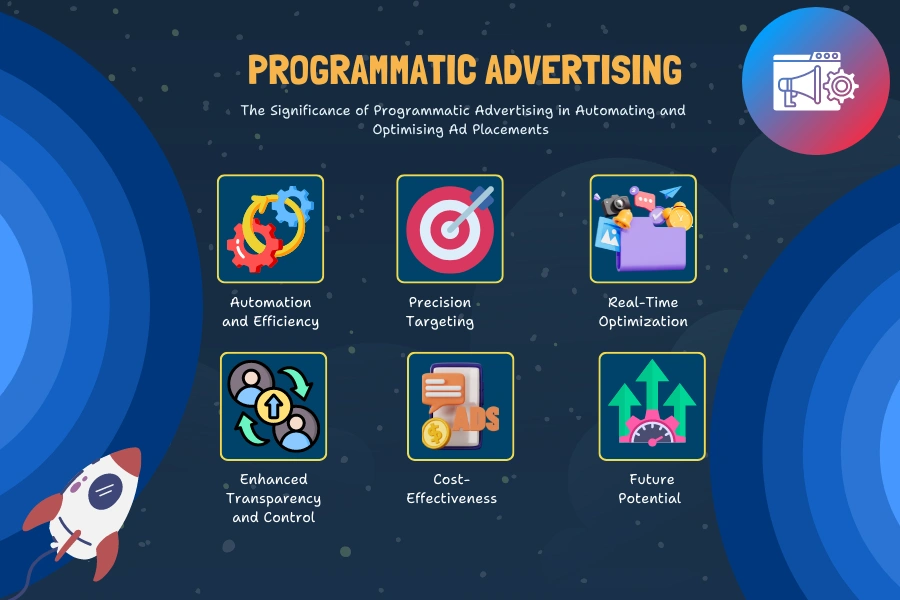The Significance of Programmatic Advertising in Automating and Optimising Ad Placements
In the fast-paced world of digital marketing, programmatic advertising has emerged as a game-changer, revolutionising the way advertisements are bought, placed, and optimised. By leveraging advanced algorithms and real-time data, programmatic advertising automates the ad buying process, ensuring precision targeting and maximising return on investment (ROI). This article delves into the significance of programmatic advertising in automating and optimising ad placements, exploring its benefits, mechanisms, and future potential.

What is Programmatic Advertising?
Programmatic advertising refers to the use of automated technology for media buying, as opposed to the traditional, manual process. It involves the use of software to purchase digital advertising space, utilising complex algorithms and real-time bidding (RTB) to deliver the right ad to the right person at the right time. This method allows marketers to target audiences more accurately and efficiently, optimising ad spend and enhancing campaign performance.
Automation and Efficiency
One of the primary benefits of programmatic advertising is its ability to automate the ad buying process. Traditionally, buying ad space involved lengthy negotiations and manual insertion orders, which were time-consuming and prone to human error. Programmatic advertising eliminates these inefficiencies by automating the entire process. Through real-time bidding, ad inventory is bought and sold in milliseconds, significantly speeding up the process and allowing for real-time adjustments based on performance data.
Precision Targeting
Programmatic advertising excels in precision targeting, enabling marketers to reach specific audiences with tailored messages. By analysing vast amounts of data, including browsing behaviour, demographics, and past purchase history, programmatic platforms can identify and target the most relevant users. This level of granularity ensures that ads are shown to individuals who are more likely to engage with them, improving conversion rates and minimising waste ad spend.
Real-Time Optimization
The ability to optimise campaigns in real time is a significant advantage of programmatic advertising. Unlike traditional advertising, where changes could take days or weeks to implement, programmatic allows for immediate adjustments based on real-time performance data. If an ad is not performing well, it can be tweaked or replaced almost instantly, ensuring that the campaign remains effective and within budget. This agility is crucial in today's dynamic digital landscape, where consumer behaviour and market conditions can change rapidly.
Enhanced Transparency and Control
Programmatic advertising provides enhanced transparency and control over ad placements. Marketers can access detailed reports on where their ads are being shown, who is seeing them, and how they are performing. This level of transparency helps in making informed decisions and optimising future campaigns. Additionally, programmatic platforms offer control over factors such as frequency capping, ad placement, and budget allocation, allowing marketers to fine-tune their strategies for maximum impact.
Cost-Effectiveness
Programmatic advertising can be highly cost-effective. By targeting only the most relevant audiences and optimising campaigns in real time, marketers can ensure that their ad spend is used efficiently. The use of real-time bidding also means that ad space is often bought at the best possible price, reducing overall costs. Moreover, the automation of the buying process reduces the need for intermediaries and manual labour, further lowering expenses.
Future Potential
The future of programmatic advertising looks promising, with continuous advancements in technology and data analytics. The integration of artificial intelligence (AI) and machine learning (ML) is expected to enhance the precision and efficiency of programmatic platforms further. AI and ML can analyse user data more accurately, predict trends, and automate more complex tasks, driving even better results for marketers. Additionally, as the digital landscape evolves, programmatic advertising is likely to expand beyond traditional display ads to include new formats such as digital out-of-home (DOOH), connected TV (CTV), and audio ads.
Programmatic advertising has transformed the digital advertising industry by automating and optimising ad placements with unprecedented precision and efficiency. Its ability to target specific audiences, optimise in real time, and provide enhanced transparency and control makes it an invaluable tool for marketers. As technology continues to evolve, the potential for programmatic advertising to deliver even greater results is immense, ensuring its significance in the digital marketing ecosystem for years to come.
Active Events
From Insights to Impact: Proven B2B Marketing Strategies for Scalable Success
Date: Feburary 28, 2025 | 7:00 PM(IST)
7:00 PM(IST) - 8:10 PM(IST)
2811 people have registered
3 Must Have Projects On your CV to Get into Data Analysis
Date: Feburary 25, 2025 | 7:00 PM(IST)
7:00 PM(IST) - 8:10 PM(IST)
2753 people registered
Bootcamps
Digital Marketing Bootcamp
- Duration:4 Months
- Start Date:Feb 9, 2025
Data Science Bootcamp
- Duration:4 Months
- Start Date:Feb 9, 2025
